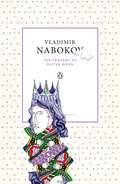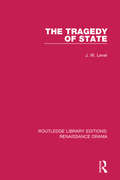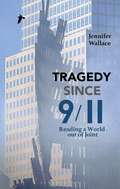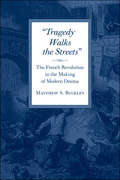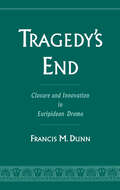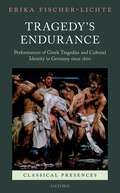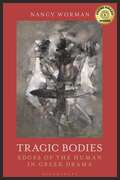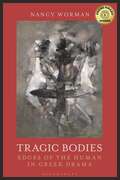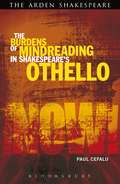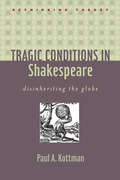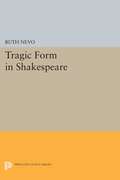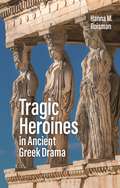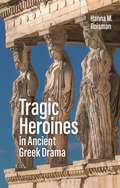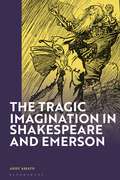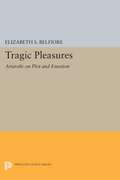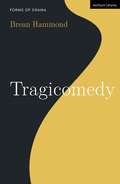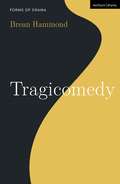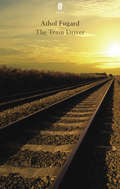- Table View
- List View
The Tragedy of Mister Morn: Lolita - A Screenplay - The Tragedy Of Mister Morn (Penguin Modern Classics)
by Vladimir Nabokov Anastasia Tolstoy Thomas KarshanMorn, a masked king, rules over a realm to which he has restored order after a violent revolution. Secretly in love with Midia, the wife of a banished revolutionary, Morn finds himself facing renewed bloodshed and disaster when Midia's husband returns, provoking a duel and the return of chaos that Morn has fought so hard to prevent. The first major work and the only play of Vladimir Nabokov, author of Lolita and Pnin, The Tragedy of Mister Morn is translated and published in English here for the first time, and is a moving study of the elusiveness of happiness, the power of imagination and the eternal battle between truth and fantasy.
The Tragedy of State (Routledge Library Editions: Renaissance Drama)
by J. W. LeverThe domination of the state over the lives of individuals is, arguably, a problem of the present-day world. In this book, first published in 1971, the author finds essentially the same problem in Jacobean tragedy in the shape it assumed during the rise of the first European nation-states. The English dramatists of the early seventeenth century a
The Tragedy of State (Routledge Library Editions: Renaissance Drama)
by J. W. LeverThe domination of the state over the lives of individuals is, arguably, a problem of the present-day world. In this book, first published in 1971, the author finds essentially the same problem in Jacobean tragedy in the shape it assumed during the rise of the first European nation-states. The English dramatists of the early seventeenth century a
Tragedy Since 9/11: Reading a World out of Joint
by Jennifer WallaceFrom the trauma of September 11th, through the wars in Afghanistan and Iraq, to the aftermath of the Arab Spring and the environmental warning signs of climate change, this book reflects on the crises and terrifying events of the early 21st century and argues that a knowledge of tragedy from the works of Sophocles to Shakespeare to Samuel Beckett can help us understand them. Jennifer Wallace offers a cultural analysis of the tragic events of the past two decades with reference to a litany of key dramatic texts, including Aeschylus' Oresteia, Euripides' Hecuba, Iphigenia in Aulis, Trojan Women and Bacchae, Homer's Iliad, Ibsen's Emperor and Galilean and Enemy of the People, and Shakespeare's Julius Caesar, Macbeth and King Lear, among others.
Tragedy Since 9/11: Reading a World out of Joint
by Jennifer WallaceFrom the trauma of September 11th, through the wars in Afghanistan and Iraq, to the aftermath of the Arab Spring and the environmental warning signs of climate change, this book reflects on the crises and terrifying events of the early 21st century and argues that a knowledge of tragedy from the works of Sophocles to Shakespeare to Samuel Beckett can help us understand them. Jennifer Wallace offers a cultural analysis of the tragic events of the past two decades with reference to a litany of key dramatic texts, including Aeschylus' Oresteia, Euripides' Hecuba, Iphigenia in Aulis, Trojan Women and Bacchae, Homer's Iliad, Ibsen's Emperor and Galilean and Enemy of the People, and Shakespeare's Julius Caesar, Macbeth and King Lear, among others.
Tragedy Walks the Streets: The French Revolution in the Making of Modern Drama
by Matthew S. BuckleyTragedy Walks the Streets challenges the conventional understanding that the evolution of European drama effectively came to a halt during France's Revolutionary era. In this interdisciplinary history on the emergence of modern drama in European culture, Matthew S. Buckley contends that the political theatricality of the Revolution tested and forced the evolution of dramatic forms, supplanting the theater itself as the primary stage of formal development. Drawing on a wide range of texts and images, he demonstrates how the social and political enlistment of dramatic theatricality inflected rising social and political tensions in pre-Revolutionary France, shaped French Revolutionary political culture, conditioned British political and cultural responses to the Revolution, and served as the impetus for Büchner’s radical formal innovations of the 1830s. Setting aside traditional boundaries of literary scholarship, Buckley pursues instead a history of dramatic form that encompasses the full range of dramatic activity in the changing cultural life of the late eighteenth and early nineteenth century, including art, architecture, journalism, political performance, and social behavior. Surveying this expanded field of inquiry, Buckley weaves together a coherent formal genealogy of the drama during this period and offers a new, more continuous generic history of modern drama in its first and most turbulent phase of development.
Tragedy's End: Closure and Innovation in Euripidean Drama
by Francis M. DunnEuripides is a notoriously problematic and controversial playwright whose innovations, according to Nietzsche, brought Greek tragedy to an early death. Dunn here argues that the infamous and artificial endings in Euripides deny the viewer access to a stable or authoritative reading of the play, while innovations in plot and ending opened tragedy up to a medley of comic, parodic, and narrative impulses. Part One explores the dramatic and metadramatic uses of novel closing gestures, such as aetiology, closing prophecy, exit lines of the chorus, and deus ex machina. Part Two shows how experimentation in plot and ending reinforce one another in Hippolytus, Trojan Women, and Heracles. Part Three argues that in three late plays, Helen, Orestes, and Phoenician Women, Euripides devises radically new and untragic ways of representing and understanding human experience. Tragedy's End is the first comprehensive study of closure in classical literature, and will be of interest to a range of students and scholars.
Tragedy's Endurance: Performances of Greek Tragedies and Cultural Identity in Germany since 1800 (Classical Presences)
by Erika Fischer-LichteThis volume sets out a novel approach to theatre historiography, presenting the history of performances of Greek tragedies in Germany since 1800 as the history of the evolving cultural identity of the educated middle class throughout that period. Philhellenism and theatromania took hold in this milieu amidst attempts to banish the heavily French-influenced German court culture of the mid-eighteenth century, and by 1800 their fusion in performances of Greek tragedies served as the German answer to the French Revolution. Tragedy's subsequent endurance on the German stage is mapped here through the responses of performances to particular political, social, and cultural milestones, from the Napoleonic Wars and the Revolution of 1848 to the Third Reich, the new political movements of the 1960s and 1970s, and the fall of the Berlin Wall and reunification. Images of ancient Greece which were prevalent in the productions of these different eras are examined closely: the Nazi's proclamation of a racial kinship between the Greeks and the Germans; the politicization of performances of Greek tragedies since the 1960s and 1970s, emblematized by Marcuse's notion of a cultural revolution; the protest choruses of the GDR and the new genre of choric theatre in the 1980s and 1990s. By examining these images and performances in relation to their respective socio-cultural contexts, the volume sheds light on how, in a constantly changing political and cultural climate, performances of Greek tragedies helped affirm, destabilize, re-stabilize, and transform the cultural identity of the educated middle class over a volatile two hundred year period.
Tragedy's Endurance: Performances of Greek Tragedies and Cultural Identity in Germany since 1800 (Classical Presences)
by Erika Fischer-LichteThis volume sets out a novel approach to theatre historiography, presenting the history of performances of Greek tragedies in Germany since 1800 as the history of the evolving cultural identity of the educated middle class throughout that period. Philhellenism and theatromania took hold in this milieu amidst attempts to banish the heavily French-influenced German court culture of the mid-eighteenth century, and by 1800 their fusion in performances of Greek tragedies served as the German answer to the French Revolution. Tragedy's subsequent endurance on the German stage is mapped here through the responses of performances to particular political, social, and cultural milestones, from the Napoleonic Wars and the Revolution of 1848 to the Third Reich, the new political movements of the 1960s and 1970s, and the fall of the Berlin Wall and reunification. Images of ancient Greece which were prevalent in the productions of these different eras are examined closely: the Nazi's proclamation of a racial kinship between the Greeks and the Germans; the politicization of performances of Greek tragedies since the 1960s and 1970s, emblematized by Marcuse's notion of a cultural revolution; the protest choruses of the GDR and the new genre of choric theatre in the 1980s and 1990s. By examining these images and performances in relation to their respective socio-cultural contexts, the volume sheds light on how, in a constantly changing political and cultural climate, performances of Greek tragedies helped affirm, destabilize, re-stabilize, and transform the cultural identity of the educated middle class over a volatile two hundred year period.
Tragic Bodies: Edges of the Human in Greek Drama
by Nancy WormanThis book argues for a new way of reading tragedy that attends to how bodies in the ancient plays pivot between subject and object, person and thing, living and dead, and so serve as vehicles for confronting the edges of the human. At the same time, it explores the ways in which Greek tragedy pulls up close to human bodies, examining their physical edges, their surfaces and parts, their coverings or nakedness, and their postures and orientations. Drawing on and advancing the latest interplays of posthumanism and materialism in relation to classical literature, Nancy Worman shows how this tragic enactment may seem to emphasize the human body, but in effect does something quite different. Greek drama instead often treats the body as a thing that has the status and implications associated with other objects, such as a cloak, an urn, or a toy for a dog.Tragic Bodies urges attention to key scenes in Greek tragedy that foreground bodily identifiers as semiotic materializing. This occurs when signs with weighty symbolic resonance distil out on the dramatic stage as concrete sites for contention and conflation orchestrated through proximity, contact, and sensory dynamics. Reading the dramatic script in this way pursues the felt knowledge at the body's edges that tragic representation affords, a consideration attuned to how bodies register at tragedy's unique intersections – where directive and figurative language combine to highlight visual, tactile, and aural details.
Tragic Bodies: Edges of the Human in Greek Drama
by Nancy WormanThis book argues for a new way of reading tragedy that attends to how bodies in the ancient plays pivot between subject and object, person and thing, living and dead, and so serve as vehicles for confronting the edges of the human. At the same time, it explores the ways in which Greek tragedy pulls up close to human bodies, examining their physical edges, their surfaces and parts, their coverings or nakedness, and their postures and orientations. Drawing on and advancing the latest interplays of posthumanism and materialism in relation to classical literature, Nancy Worman shows how this tragic enactment may seem to emphasize the human body, but in effect does something quite different. Greek drama instead often treats the body as a thing that has the status and implications associated with other objects, such as a cloak, an urn, or a toy for a dog.Tragic Bodies urges attention to key scenes in Greek tragedy that foreground bodily identifiers as semiotic materializing. This occurs when signs with weighty symbolic resonance distil out on the dramatic stage as concrete sites for contention and conflation orchestrated through proximity, contact, and sensory dynamics. Reading the dramatic script in this way pursues the felt knowledge at the body's edges that tragic representation affords, a consideration attuned to how bodies register at tragedy's unique intersections – where directive and figurative language combine to highlight visual, tactile, and aural details.
Tragic Cognition in Shakespeare's Othello: Beyond the Neural Sublime (Shakespeare Now!)
by Paul CefaluPaul Cefalu argues that Shakespearean characters raise timely questions about the relationship between cognition and consciousness and often defy our assumptions about "normal†? cognition. The book will appeal to scholars and students interested in both the virtuesand limitations of cognitive literary criticism.
Tragic Cognition in Shakespeare's Othello: Beyond the Neural Sublime (Shakespeare Now!)
by Paul CefaluPaul Cefalu argues that Shakespearean characters raise timely questions about the relationship between cognition and consciousness and often defy our assumptions about “normal” cognition. The book will appeal to scholars and students interested in both the virtuesand limitations of cognitive literary criticism.
Tragic Conditions in Shakespeare: Disinheriting the Globe (Rethinking Theory)
by Paul A. KottmanPaul A. Kottman offers a new and compelling understanding of tragedy as seen in four of Shakespeare’s mature plays—As You Like It, Hamlet, King Lear, and The Tempest. The author pushes beyond traditional ways of thinking about tragedy, framing his readings with simple questions that have been missing from scholarship of the past generation: Are we still moved by Shakespeare, and why? Kottman throws into question the inheritability of human relationships by showing how the bonds upon which we depend for meaning and worth can be dissolved. According to Kottman, the lives of Shakespeare's protagonists are conditioned by social bonds—kinship ties, civic relations, economic dependencies, political allegiances—that unravel irreparably. This breakdown means they can neither inherit nor bequeath a livable or desirable form of sociality. Orlando and Rosalind inherit nothing "but growth itself" before becoming refugees in the Forest of Arden; Hamlet is disinherited not only by Claudius’s election but by the sheer vacuity of the activities that remain open to him; Lear’s disinheritance of Cordelia bequeaths a series of events that finally leave the social sphere itself forsaken of heirs and forbearers alike. Firmly rooted in the philosophical tradition of reading Shakespeare, this bold work is the first sustained interpretation of Shakespearean tragedy since Stanley Cavell’s work on skepticism and A. C. Bradley’s century-old Shakespearean Tragedy.
Tragic Form in Shakespeare
by Ruth NevoA "symbolist" approach has dominated Shakespearean criticism for many years, but Ruth Nevo believes that the emphasis on static and pictorial aspects has obscured the essentially dynamic nature of dramatic expression and this study of the development of Shakespeare's tragic form is offered to correct the imbalance.From detailed analyses of each of Shakespeare's ten tragedies emerges a characteristic structure—a five-phased movement of discovery—that articulates and orders the traditional components of tragedy. This sequence is one of predicament, psychomachia, peripeteia, perspectives of irony and pathos, and catastrophe. It is a continuous, accumulative, and consummatory one, rather than a simple up-down movement or even a more complex thesis-antithesis-synthesis. Inheriting a five-act model and its developed rationale, Shakespeare used it to express an ever richer and more complex tragic experience. As the protagonist's life unfolds before us, the development of his tragic recognition is coextensive with the whole of the action.Originally published in 1972.The Princeton Legacy Library uses the latest print-on-demand technology to again make available previously out-of-print books from the distinguished backlist of Princeton University Press. These editions preserve the original texts of these important books while presenting them in durable paperback and hardcover editions. The goal of the Princeton Legacy Library is to vastly increase access to the rich scholarly heritage found in the thousands of books published by Princeton University Press since its founding in 1905.
Tragic Heroines in Ancient Greek Drama
by Hanna M. RoismanThe heroines of Greek tragedy presented in the plays by Aeschylus, Sophocles and Euripides have long captivated audiences and critics. In this volume each of the eleven chapters discusses one of the heroines: Clytemnestra, Hecuba, Medea, Iphigenia, Alcestis, Antigone Electra, Deianeira, Phaedra, Creusa and Helen. The book focuses on characterisation and the motivations of the women, as well as on those of the male playwrights, and offers multiple viewpoints and critiques that enable readers to understand the context of each play and form their own views. Four core themes bridge the depictions of the heroines: the socio-political dynamic of ancient Greek expectations of women and their roles in society, the conflict of masculinity versus femininity, the alternation of defiance and submission, and the interplay between deceit and rhetoric. Each chapter offers clear descriptions of plot and mythical background, and builds on the text of the plays to enable reflections on language and performance. All technical terms are explained and key topics or references are pulled out into box features that provide further background information. Discussion points at the ends of chapters enable readers to explore various topics more deeply.
Tragic Heroines in Ancient Greek Drama
by Hanna M. RoismanThe heroines of Greek tragedy presented in the plays by Aeschylus, Sophocles and Euripides have long captivated audiences and critics. In this volume each of the eleven chapters discusses one of the heroines: Clytemnestra, Hecuba, Medea, Iphigenia, Alcestis, Antigone Electra, Deianeira, Phaedra, Creusa and Helen. The book focuses on characterisation and the motivations of the women, as well as on those of the male playwrights, and offers multiple viewpoints and critiques that enable readers to understand the context of each play and form their own views. Four core themes bridge the depictions of the heroines: the socio-political dynamic of ancient Greek expectations of women and their roles in society, the conflict of masculinity versus femininity, the alternation of defiance and submission, and the interplay between deceit and rhetoric. Each chapter offers clear descriptions of plot and mythical background, and builds on the text of the plays to enable reflections on language and performance. All technical terms are explained and key topics or references are pulled out into box features that provide further background information. Discussion points at the ends of chapters enable readers to explore various topics more deeply.
The Tragic Imagination in Shakespeare and Emerson
by Andy AmatoWhat is the “tragic imagination”? And what role does it play in the works of William Shakespeare and Ralph Waldo Emerson? Explaining the tragic imagination as a creative faculty employed to answer the perennial Riddle of the Sphinx – a theory of the world that advances human freedom and dignity in the face of historical injustice, cruelty and violence – Andy Amato seeks to recover and rehabilitate this concept by revealing its significance to both key works of philosophy and literature and our contemporary world. This book begins with a close and careful reading of Emerson's first major work, Nature, in conversation with nineteenth and 20thcentury continental philosophy, critical theory and post-structuralism. Uncovering neglected elements of Emerson's philosophy, beyond his reputation as the philosopher of 'cheer', this book explores how Emersonian transcendentalism affirms rather than denies the tragic sense of life – “tragic idealism” – and makes a substantial contribution to philosophy's perpetual endeavour to solve the Riddle. In the second part of the book, Amato then employs Emerson's theoretical lens to interpret Shakespeare's tragedy, King Lear. In doing so, he innovatively reframes the central themes of suffering, vision, nature, nothing, foolishness and silence toward achieving liberation.By pairing these two giants of literature and philosophy, The Tragic Imagination in Shakespeare and Emerson not only offers fresh interpretations of Nature and King Lear, but also makes the case for the renewed deployment of tragic imagination, in creative redress, to our current social-political situation.
The Tragic Imagination in Shakespeare and Emerson
by Andy AmatoWhat is the “tragic imagination”? And what role does it play in the works of William Shakespeare and Ralph Waldo Emerson? Explaining the tragic imagination as a creative faculty employed to answer the perennial Riddle of the Sphinx – a theory of the world that advances human freedom and dignity in the face of historical injustice, cruelty and violence – Andy Amato seeks to recover and rehabilitate this concept by revealing its significance to both key works of philosophy and literature and our contemporary world. This book begins with a close and careful reading of Emerson's first major work, Nature, in conversation with nineteenth and 20thcentury continental philosophy, critical theory and post-structuralism. Uncovering neglected elements of Emerson's philosophy, beyond his reputation as the philosopher of 'cheer', this book explores how Emersonian transcendentalism affirms rather than denies the tragic sense of life – “tragic idealism” – and makes a substantial contribution to philosophy's perpetual endeavour to solve the Riddle. In the second part of the book, Amato then employs Emerson's theoretical lens to interpret Shakespeare's tragedy, King Lear. In doing so, he innovatively reframes the central themes of suffering, vision, nature, nothing, foolishness and silence toward achieving liberation.By pairing these two giants of literature and philosophy, The Tragic Imagination in Shakespeare and Emerson not only offers fresh interpretations of Nature and King Lear, but also makes the case for the renewed deployment of tragic imagination, in creative redress, to our current social-political situation.
Tragic Pleasures: Aristotle on Plot and Emotion
by Elizabeth S. BelfioreElizabeth Belfiore offers a striking new interpretation of Aristotle's Poetics by situating the work within the Aristotelian corpus and in the context of Greek culture in general. In Aristotle's Rhetoric, the Politics, and the ethical, psychological, logical, physical, and biological works, Belfiore finds extremely important but largely neglected sources for understanding the elliptical statements in the Poetics. The author argues that these Aristotelian texts, and those of other ancient writers, call into question the traditional view that katharsis in the Poetics is a homeopathic process--one in which pity and fear affect emotions like themselves. She maintains, instead, that Aristotle considered katharsis to be an allopathic process in which pity and fear purge the soul of shameless, antisocial, and aggressive emotions. While exploring katharsis, Tragic Pleasures analyzes the closely related question of how the Poetics treats the issue of plot structure. In fact, Belfiore's wide-ranging work eventually discusses every central concept in the Poetics, including imitation, pity and fear, necessity and probability, character, and kinship relations.Originally published in 1992.The Princeton Legacy Library uses the latest print-on-demand technology to again make available previously out-of-print books from the distinguished backlist of Princeton University Press. These editions preserve the original texts of these important books while presenting them in durable paperback and hardcover editions. The goal of the Princeton Legacy Library is to vastly increase access to the rich scholarly heritage found in the thousands of books published by Princeton University Press since its founding in 1905.
Tragicomedy (Forms of Drama)
by Brean HammondThis succinct authoritative book offers readers an overview of the origins, characteristics, and changing status of tragicomedy from the 17th century to the present. It explores the work of some of the key English and Irish playwrights associated with the form, the influence of Italian and Spanish theorist-playwrights and the importance of translations of Pierre Corneille's Le Cid. At the turn of the 17th century, English dramatists such as John Marston, John Fletcher, and William Shakespeare began experimenting with plays that mixed elements of tragedy and comedy, producing a blended mode that they themselves called 'tragicomedy'. This book begins by examining the sources of their inspiration and the theatrical achievement that they hoped to gain by confronting an audience with plays that defied the plot and character expectations of 'pure' comedy and tragedy. It goes on to show how, reacting to French models, John Dryden, Shakespeare 'improvers' and other English playwrights developed the form while sowing the seeds of its own vulnerability to parody and obsolescence in the eighteenth century. Discussing nineteenth-century melodrama as in some respects a resurrection of tragicomedy, the final chapter concentrates on plays by Ibsen, Chekhov, and Beckett as examples of the form being revived to create theatrical modes that more adequately represent the perceived complexity of experience.
Tragicomedy (Forms of Drama)
by Brean HammondThis succinct authoritative book offers readers an overview of the origins, characteristics, and changing status of tragicomedy from the 17th century to the present. It explores the work of some of the key English and Irish playwrights associated with the form, the influence of Italian and Spanish theorist-playwrights and the importance of translations of Pierre Corneille's Le Cid. At the turn of the 17th century, English dramatists such as John Marston, John Fletcher, and William Shakespeare began experimenting with plays that mixed elements of tragedy and comedy, producing a blended mode that they themselves called 'tragicomedy'. This book begins by examining the sources of their inspiration and the theatrical achievement that they hoped to gain by confronting an audience with plays that defied the plot and character expectations of 'pure' comedy and tragedy. It goes on to show how, reacting to French models, John Dryden, Shakespeare 'improvers' and other English playwrights developed the form while sowing the seeds of its own vulnerability to parody and obsolescence in the eighteenth century. Discussing nineteenth-century melodrama as in some respects a resurrection of tragicomedy, the final chapter concentrates on plays by Ibsen, Chekhov, and Beckett as examples of the form being revived to create theatrical modes that more adequately represent the perceived complexity of experience.
The Train Driver
by Athol FugardIn December 2000, Pumla Lolwana pulled her three children close to her body and stepped in front of a train on the railway tracks between Philippi and Nyanga on the Cape Flats, South Africa.This true story demanded Athol Fugard's attention and compelled him to write The Train Driver; a beautiful and haunting play of redemptive power. The Train Driver received its UK premiere at Hampstead Theatre, London, in November 2010.'Brave, confrontational and tender . . . Essential theatre viewing.' Sunday Times, South Africa
